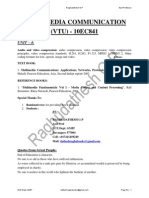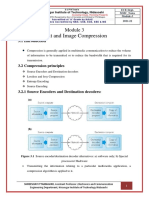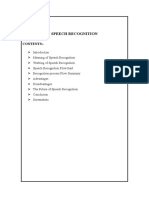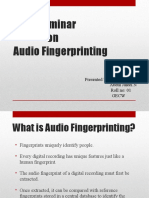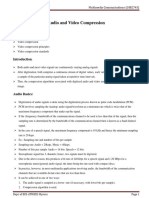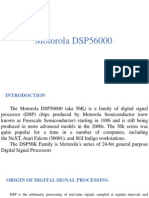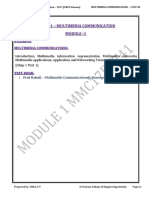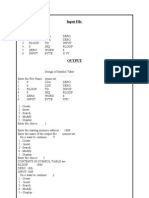Dolby Audio Coders
Dolby Audio Coders
Uploaded by
Abhishek BoseCopyright:
Available Formats
Dolby Audio Coders
Dolby Audio Coders
Uploaded by
Abhishek BoseOriginal Description:
Original Title
Copyright
Available Formats
Share this document
Did you find this document useful?
Is this content inappropriate?
Copyright:
Available Formats
Dolby Audio Coders
Dolby Audio Coders
Uploaded by
Abhishek BoseCopyright:
Available Formats
Dolby Audio Coders
Forward adaptive bit allocation
Fixed bit allocation(Dolby AC-1)
Backward adaptive bit allocation(Dolby AC2)
Dolby AC-3
Linear predictive coding (LPC) signal encoder and decoder
Linear predictive coding involves the source simply analyzing the audio waveform to determine a selection of the perceptual features it contains
Linear predictive coding
With this type of coding the perceptual features of an audio waveform are analysed first These are then quantized and sent and the destination uses them, together with a sound synthesizer, to regenerate a sound that is perceptually comparable with the source audio signal With this compression technique although the speech can often sound synthetic high levels of compressions can be achieved In terms of speech, the three features which determine the perception of a signal by the ear are its: Pitch: this is closely related to the frequency of the signal. This is important since ear is more sensitive to signals in the range 2-5kHz Period: this is the duration of the signal Loudness: This is determined by the amount of energy in the signal
Linear predictive coding
The input speech waveform is first sampled and quantized at a defined rate A block of digitized samples known as segment - is then analysed to determine the various perceptual parameters of the speech that it contains The output of the encoder is a string of frames, one for each segment Each frame contains fields for pitch and loudness the period determined by the sampling rate being used a notification of whether the signal is voiced (generated through the vocal cords) or unvoiced (vocal cords are opened) And a new set of computed modal coefficients
You might also like
- Spatial Filters in Image ProcessingDocument68 pagesSpatial Filters in Image ProcessingMudassir RafiqNo ratings yet
- 14ec3029 Speech and Audio Signal ProcessingDocument30 pages14ec3029 Speech and Audio Signal ProcessingSugumar Sar DuraiNo ratings yet
- Mmc-Unit 2Document66 pagesMmc-Unit 2Nivedita Damodar100% (1)
- Multimedia Commnication Unit 4 VTUDocument41 pagesMultimedia Commnication Unit 4 VTUraghudathesh100% (1)
- Chapter 4 Video and AnimationDocument16 pagesChapter 4 Video and Animationrp100% (1)
- ARM Lab MannualDocument136 pagesARM Lab MannualRanjith M KumarNo ratings yet
- MMC Notes Module 3Document24 pagesMMC Notes Module 3Tanveer ShaikhNo ratings yet
- Multimedia Communication - ECE - VTU - 8th Sem - Unit 3 - Text and Image Compression, RamisuniverseDocument30 pagesMultimedia Communication - ECE - VTU - 8th Sem - Unit 3 - Text and Image Compression, Ramisuniverseramisuniverse83% (6)
- Face Recognition Using Neural Network: Seminar ReportDocument33 pagesFace Recognition Using Neural Network: Seminar Reportnikhil_mathur10100% (3)
- MMC Module 3Document20 pagesMMC Module 3Chandra Shekar MedarNo ratings yet
- Multimedia Communication - ECE - VTU - 8th Sem - Unit 2 - Multimedia Information RepresentationDocument29 pagesMultimedia Communication - ECE - VTU - 8th Sem - Unit 2 - Multimedia Information Representationramisuniverse100% (2)
- MMC 17EC741 Module 4 NotesDocument21 pagesMMC 17EC741 Module 4 NotesAKSHATA R CNo ratings yet
- Embedded SystemDocument21 pagesEmbedded SystemDeepak Sharma79% (33)
- Speech Recognition ReportDocument20 pagesSpeech Recognition ReportRamesh k100% (1)
- Fingerprint Based Electronic Voting MachineDocument20 pagesFingerprint Based Electronic Voting MachineAnjali yadavNo ratings yet
- MMC Module 5Document12 pagesMMC Module 5Chandra Shekar MedarNo ratings yet
- Chapter 16 - Multimedia Network Communications and ApplicationsDocument68 pagesChapter 16 - Multimedia Network Communications and ApplicationsFarzaan Pardiwala100% (2)
- Unit 2 - Audio and Video CompressionDocument59 pagesUnit 2 - Audio and Video Compressionvanithapremkumar100% (2)
- Mixed Signal TestDocument14 pagesMixed Signal TestperiodoNo ratings yet
- Dip Notes 17ec72 Lecture Notes 1 5Document204 pagesDip Notes 17ec72 Lecture Notes 1 5Prakash SaubhariNo ratings yet
- Ec8702-Adhoc and Wireless Sensor Networks-Unit NotesDocument374 pagesEc8702-Adhoc and Wireless Sensor Networks-Unit NotesrahulNo ratings yet
- Digital Video ProcessingDocument261 pagesDigital Video ProcessingmuthubeNo ratings yet
- Digitizing The Video SignalDocument18 pagesDigitizing The Video SignalHarini RaoNo ratings yet
- Group No.-4 - PPTDocument23 pagesGroup No.-4 - PPTRadhika SharmaNo ratings yet
- Human Hand Gestures Capturing and Recognition Via CameraDocument64 pagesHuman Hand Gestures Capturing and Recognition Via CameraBharathNo ratings yet
- Speech RecognitionDocument17 pagesSpeech RecognitionanishaNo ratings yet
- Module 1 Notes (17EC81)Document16 pagesModule 1 Notes (17EC81)gagan mrNo ratings yet
- AI DesktopDocument14 pagesAI DesktopAnubhav singhNo ratings yet
- Compiling, Linking, and LocatingDocument20 pagesCompiling, Linking, and LocatingAravindNo ratings yet
- Seminar On Audio Fingerprinting: Presented By: Abdul Jaleel.N Roll No: 01 GecwDocument19 pagesSeminar On Audio Fingerprinting: Presented By: Abdul Jaleel.N Roll No: 01 GecwarjunrajmpNo ratings yet
- Real Time DSPDocument4 pagesReal Time DSPMuhammadNo ratings yet
- Module 1Document53 pagesModule 1tarunkumarsj117No ratings yet
- Multimedia HardWareDocument18 pagesMultimedia HardWareRohan GuptaNo ratings yet
- MPMC Lab Manual ExpsDocument29 pagesMPMC Lab Manual ExpsJanardhan ChNo ratings yet
- 18EC743-MMC-Module-4 NotesDocument45 pages18EC743-MMC-Module-4 Notesmkhushim83No ratings yet
- DSP (18EC52) Course File PlanningDocument7 pagesDSP (18EC52) Course File PlanningShravan KumarNo ratings yet
- Data Compression Seminar ReportDocument34 pagesData Compression Seminar ReportRahul Biradar67% (6)
- Motorola DSP 56kDocument6 pagesMotorola DSP 56kGuțu EugenNo ratings yet
- IAT-I Question Paper With Solution of 15EC741 Multimedia Communication Sep-2019-Pappa M, Dr.K.P.SharmilaDocument18 pagesIAT-I Question Paper With Solution of 15EC741 Multimedia Communication Sep-2019-Pappa M, Dr.K.P.SharmilaBoban MathewsNo ratings yet
- Chapter 12 - ADC TestingDocument87 pagesChapter 12 - ADC TestingMonal Bhoyar100% (1)
- Multimedia Communication Vtu Unit 2Document54 pagesMultimedia Communication Vtu Unit 2raghudathesh100% (1)
- Part - B Unit - 5 Multimedia Information Networks Introduction, Lans, Ethernet, Token Ring, Bridges, Fddi High-Speed Lans, Lan Protocol. 7 HoursDocument33 pagesPart - B Unit - 5 Multimedia Information Networks Introduction, Lans, Ethernet, Token Ring, Bridges, Fddi High-Speed Lans, Lan Protocol. 7 HoursDeepa JerinNo ratings yet
- Multimedia and AnimationDocument40 pagesMultimedia and AnimationSwati KalaniNo ratings yet
- EC8702 Adhoc SyllabusDocument3 pagesEC8702 Adhoc SyllabusThahsin ThahirNo ratings yet
- Voice Morphing Final ReportDocument33 pagesVoice Morphing Final ReportrahuljindalNo ratings yet
- 17ec741 Module - 1Document54 pages17ec741 Module - 1Chinmay NaikNo ratings yet
- CS3691 Embedded System and IotDocument30 pagesCS3691 Embedded System and IotKuzhal ArasiNo ratings yet
- (WWW Vtuworld Com) Multimedia-Communication-Notes PDFDocument220 pages(WWW Vtuworld Com) Multimedia-Communication-Notes PDFAbhinavNo ratings yet
- Ktu SyllabusDocument87 pagesKtu SyllabusPratheesh BoseNo ratings yet
- JNTUK M.Tech R13 CNC SyllabusDocument18 pagesJNTUK M.Tech R13 CNC Syllabuschakri474No ratings yet
- Unit - 5 Embedded System DevelopmentDocument25 pagesUnit - 5 Embedded System DevelopmentMurali Dhara Sesha Giri Rao GoddantiNo ratings yet
- MC 18ec46 Mod1Document19 pagesMC 18ec46 Mod1kirthi bharadwajNo ratings yet
- Speech Recognition SeminarDocument19 pagesSpeech Recognition Seminargoing12345No ratings yet
- Chapter1 IntroductionDocument24 pagesChapter1 IntroductionChikgu Pazleech100% (1)
- Unit - 3 Programming The Basic ComputerDocument29 pagesUnit - 3 Programming The Basic ComputerAnanya SinhaNo ratings yet
- Unit 3Document14 pagesUnit 3DivyavarshiniNo ratings yet
- Digital Image ProcessingDocument129 pagesDigital Image ProcessingNEW TAMIL HD MOVIESNo ratings yet
- Human Speech Producing Organs: 2.4 KbpsDocument108 pagesHuman Speech Producing Organs: 2.4 KbpsdfbbvcxNo ratings yet
- Speech Compression (2)Document37 pagesSpeech Compression (2)muthukumarveveaham538No ratings yet
- Audio and Video CompresssionDocument61 pagesAudio and Video Compresssionbharathivenkat25100% (1)
- Unit-Ii Itc 2302Document21 pagesUnit-Ii Itc 2302Abhishek Bose100% (1)
- 5014 Symbol Table Program:: (Program Name - Symtab.c)Document39 pages5014 Symbol Table Program:: (Program Name - Symtab.c)Abhishek BoseNo ratings yet
- Unit-Ii ItcDocument42 pagesUnit-Ii ItcAbhishek BoseNo ratings yet
- Index: Exp. No. Date Given Name of The Experiment No Date of Submission Marks SignDocument1 pageIndex: Exp. No. Date Given Name of The Experiment No Date of Submission Marks SignAbhishek BoseNo ratings yet
- Relocating LoaderDocument6 pagesRelocating LoaderAbhishek BoseNo ratings yet
- Unit 1Document45 pagesUnit 1Abhishek Bose100% (2)
- Input File: (File Name - SyminDocument13 pagesInput File: (File Name - SyminAbhishek BoseNo ratings yet
- ASR1Document5 pagesASR1Abhishek BoseNo ratings yet
- Unit IiDocument34 pagesUnit IiAbhishek BoseNo ratings yet
- IMAGE CompressionDocument27 pagesIMAGE CompressionAbhishek Bose0% (1)
- Itc Unit-IiiDocument58 pagesItc Unit-IiiAbhishek BoseNo ratings yet
- Information Capacity TheoremDocument9 pagesInformation Capacity TheoremAbhishek BoseNo ratings yet
- Mpeg 4 PDFDocument53 pagesMpeg 4 PDFAbhishek BoseNo ratings yet
- Production FunctionDocument22 pagesProduction FunctionAbhishek BoseNo ratings yet
- Unit V: Financial AccountingDocument31 pagesUnit V: Financial AccountingAbhishek Bose100% (2)
- Eco Unit 4Document11 pagesEco Unit 4Abhishek BoseNo ratings yet
- Eco Unit 3Document7 pagesEco Unit 3Abhishek BoseNo ratings yet
- Returns To ScaleDocument12 pagesReturns To ScaleAbhishek Bose50% (4)



